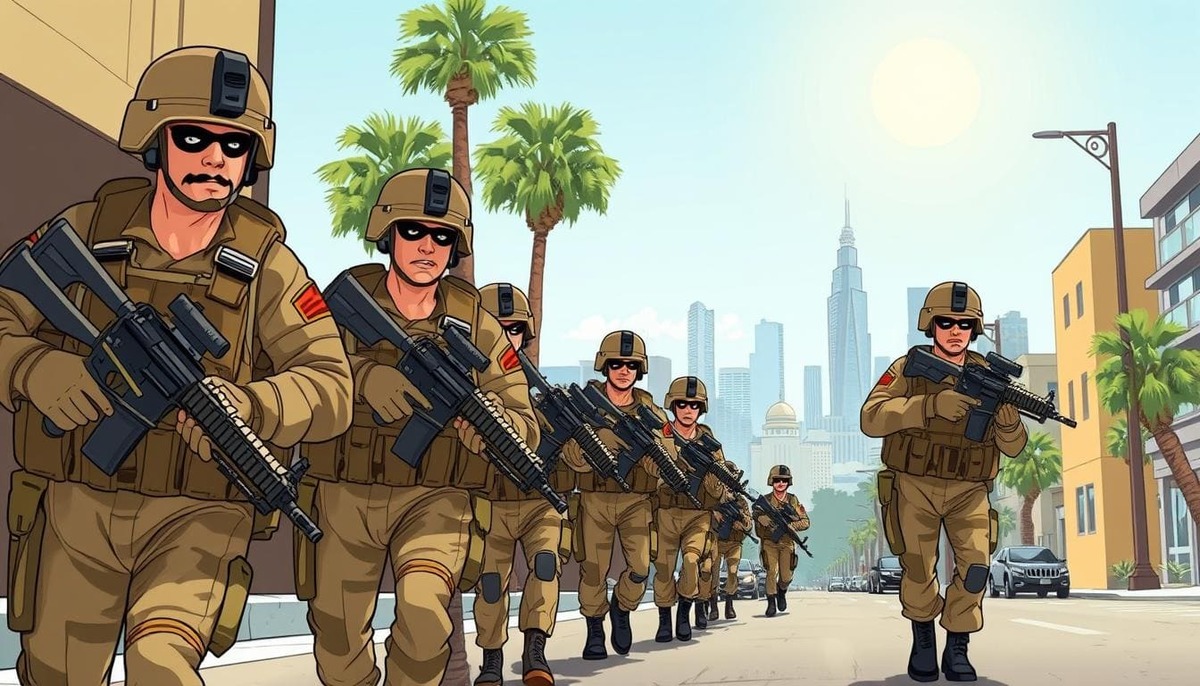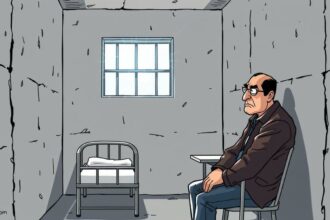
Camouflaged uniforms. Heavy boots on pavement. The sight of military forces in Westlake’s Latino neighborhoods has left Los Angeles residents uneasy—and officials divided. Why are Marines here, and who decides their rules of engagement?
Mayor Karen Bass calls it «fear and panic,» while the White House insists the city is «under siege.» Meanwhile, the LAPD claims control. The irony? The same motto—«This We’ll Defend»—hangs over Defense Secretary memos and ICE raid photos alike.
A federal judge will soon weigh in, with an emergency hearing set for June 13. Could this legal showdown redefine how the United States deploys its armed forces at home? The answer might surprise you.
Introduction: National Guard Deployment Sparks Tensions in Los Angeles
What began as a routine check at a Home Depot parking lot spiraled into a citywide crisis. On June 7, 2025, a clash between day laborers and officers ignited protests—but no one expected armored convoys to roll in days later.
Background on the 2025 Protests and Federal Response
By June 11, social media exploded with images of rifle-toting soldiers standing over handcuffed suspects. The federal government confirmed Marines had just completed civil disturbance training at Naval Base Ventura County. A crash course in crowd control, some whispered.
Yet as protest numbers dwindled, the presence of military personnel grew. Locals watched in disbelief. «Parece ocupación, no protección,» muttered a taco vendor, wiping his hands on his apron. «It feels like occupation, not protection.»
- Rapid escalation: A Home Depot raid snowballed into citywide operations.
- Visible force: Soldiers in full gear patrolled sidewalks, sparking debates about law enforcement boundaries.
- Training gap: Marines trained for war zones—not neighborhood de-escalation.
The irony? While officials called it a «stabilization mission,» residents saw a neighborhood under siege. And the legal battles were just beginning.
The National Guard’s Dual Role: State vs. Federal Authority
Wildfires to raids: California’s forces face a role they never trained for. Typically seen battling flames or handing out sandbags, they’re now navigating a legal gray zone—one defined by two federal statutes: Title 32 and Title 10.
Title 32 vs. Title 10 Activation: Key Differences
Under Title 32, the state national guard can assist local law enforcement—think traffic control during disasters. But Title 10? That’s full federalization. «This isn’t your abuelo’s National Guard,» a Pentagon insider quipped, referencing the 2,000 troops repurposed from building security to raid support in 48 hours.
The last time a president bypassed a governor? 1965, when LBJ sent soldiers to Alabama during civil rights marches. Today’s paperwork shuffle mirrors that precedent—but with a twist.
| Activation Type | Authority | Law Enforcement Role |
|---|---|---|
| Title 32 | State | Permitted |
| Title 10 | Federal government | Prohibited |
Imagine swapping shovels for handcuffs. That’s the reality for California’s armed forces, whose usual wildfire kits now include riot gear. The federal government insists this is «logistical support.» Critics argue it’s overreach.
When does authority blur into control? The answer might lie in those midnight memos—and who signed them.
Historical Precedents for Domestic Military Deployments
Armored Humvees now stand where cattle trucks once rolled. The military playbook for mass deportations isn’t new—but the 2025 version has sharper teeth. Seventy years ago, Eisenhower’s «Operation Wetback» rounded up over a million people in raids that still scar Latino communities.
From Eisenhower’s Playbook to 2025
Back then, 700 agents used cattle trucks to transport detainees. Today? Over 4,700 forces patrol in armored vehicles. «History isn’t repeating—it’s remixing,» says immigration scholar Dr. Elena Ruiz. The parallels are eerie:
- Scale: Eisenhower’s 1954 operations lasted months; Trump’s 2025 surge deployed faster than a wildfire.
- Symbolism: Stephen Miller keeps a framed Eisenhower photo in his office—a not-so-subtle nod to the «model.»
- Stories: Families still whisper about ’54 raids. «Abuela hid in a flour barrel,» shares L.A. resident Carlos Mendez.
The military tactics may have upgraded, but the fear remains the same. As one protest sign reads: «Same storm, different boots.»
ICE and National Guard Collaboration: How It’s Unfolding
Rifle muzzles dominated the frame—the photo ICE didn’t want you to see. A since-deleted X post showed soldiers in tactical gear during a June 11 operation, their faces blurred but weapons crystal clear. The image sparked outrage, forcing DHS to admit troops could «temporarily detain» protesters.
Photos of Armed Troops at Raids Stir Controversy
The viral photo’s composition told its own story: rifles angled toward the camera, postures rigid. An internal ICE memo later surfaced, advising personnel to use «visual deterrence» tactics. «It’s not just about arrests—it’s about sending a message,» a redacted line read.
Contrast this with 2010’s «Shield Arizona,» where Border Patrol focused on desert checkpoints. Today’s urban ops involve armored vehicles and block-by-block sweeps. Domestic law enforcement has never looked more militarized.
- Training gaps: A private’s diary excerpt revealed: «Day 3: Handed cuffs. Never trained for this.»
- Legal loopholes: The Posse Comitatus Act, which limits power, now has «more holes than Swiss cheese,» argues constitutional lawyer Lina Rivera.
- Public backlash: ICE’s deleted post garnered 500K views before vanishing—but screenshots live on.
«This isn’t a peacekeeping mission—it’s a show of force disguised as policy.»
—Lina Rivera, Constitutional Law Professor
As debates rage over blurred lines between protection and intimidation, one thing is clear: the rules of engagement are being rewritten in real time.
Legal Challenges: California’s Emergency Lawsuit Explained
Legal papers hit the federal docket like a grenade—California wasn’t asking, it was demanding. The state’s 28-page lawsuit argues the federal government overstepped by deploying Marines under the Insurrection Act. «This is constitutional ju-jitsu,» quipped an ACLU attorney, flipping the script on Washington’s playbook.
Allegations of Overreach Under the Insurrection Act
California’s filing hinges on 10 U.S.C. § 246, a dusty militia clause that limits military power on home soil. The last time this law sparked drama? 1992, when the 9th Circuit ruled soldiers couldn’t act as cops during the LA riots. History’s echo is deafening.
- Street-smart legalese: The suit compares today’s raids to Eisenhower’s 1954 mass deportations—a rights violation, not a rescue mission.
- Newsom’s margin notes: The governor scribbled «Hell no» beside a paragraph about federal authority. His legal team kept it in.
- Courtroom drama: Sketch artists captured the judge’s skepticism—eyebrows arched at claims of an «insurrection.»
| Legal Weapon | California’s Argument | Federal Counter |
|---|---|---|
| 10 U.S.C. § 246 | Blocks militarized policing | «Logistical support» loophole |
| 1992 Precedent | No soldier-as-cop precedent | «Enhanced public safety» |
«They’re using a sledgehammer to swat a fly. The law was meant for rebellions, not parking lot arrests.»
—ACLU Attorney Maria Velasquez
As families held their breath, one thing became clear: this wasn’t just about power. It was about who gets to define it.
The Marines’ Role: Civil Disturbance Training and Rules of Force
Boots meant for desert sand now tread on city concrete—Marines from Camp Pendleton find themselves in unfamiliar territory. The 1st Marine Division, fresh from Pacific war games, received a 72-hour crash course in urban safety. «Think Fallujah, but with traffic cones,» joked an instructor in a leaked training video.
From Battlefields to Barricades
Their training manual usually covers IED detection. Now? It includes protest sign analysis. The jarring shift left many soldiers uneasy. One corporal confessed: «We’re fish out of water here. MacArthur Park isn’t exactly a combat zone.»
The leaked video shows Marines role-playing with «agitated civilians»—some holding cardboard signs, others shouting. Military personnel practiced de-escalation, but their body language screamed «mission confusion.»
- Rules of Engagement: In Fallujah, Marines could return fire. On Figueroa Street, their rifles stayed slung—mostly.
- Gear Swap: Tactical vests replaced flak jackets, yet the weight of scrutiny felt heavier.
«We train to dominate. Now they want us to negotiate? That’s a whole different operations manual.»
—Anonymous Marine Corporal
Public Safety or Political Theater? Debating the Troop Surge
Donut crumbs and riot gear—an unlikely combo on L.A. streets. While viral videos showed cops sharing snacks with protesters, Marines stood rigid blocks away. «We’re not singing ‘Kumbaya’ with rifles,» muttered an LAPD sergeant, summing up the disconnect.
LAPD’s Stance: “They Have a Different Mission”
Chief McDonnell’s press conference remarks revealed the strain: «We de-escalate. They deter.» The stats backed him up—an 87% drop in protest arrests since deployment. But at what cost? Internal memos warned of mission creep, with one captain scribbling: «Since when do we need armored vehicles for graffiti cleanup?»
Police scanners captured the chaos during joint operations:
- «Why are they here?» An officer’s frustrated transmission during a MacArthur Park standoff.
- Conflicting orders: Cops told to «stand down» while military personnel moved in.
- Community whiplash: The same streets where LAPD hosted basketball games now had checkpoints.
«This isn’t safety—it’s occupation. We know real law enforcement. This ain’t it.»
—Tomas Rivera, Gang Intervention Worker
The city’s dilemma? Praise the calm while questioning its cause. As one councilmember put it: «You don’t cure a headache with a sledgehammer.» With tensions simmering, even donuts couldn’t sweeten this debate.
Stephen Miller’s Influence: Expanding Deportation Tactics

Stephen Miller’s Sharpie circled Home Depot locations on a map, turning parking lots into hunting grounds. The May 25 meeting at ICE headquarters wasn’t about policy—it was a power play. «Consider this your new morning commute,» he reportedly told agents, sliding satellite images of hardware stores across the table.
Home Depot Raids as a Blueprint
The «30 in 30» challenge became ICE’s open secret—agents competing to make 30 arrests in 30 minutes. Text logs show frantic updates: «Got 12 by plumbing, moving to lumber.» By June, this operations model spread to 7-Elevens and laundromats.
One agent’s confession stung: «We’re becoming mall cops with badges.» The 300% spike in non-criminal arrests revealed a stark shift. Biden-era targeted removals gave way to dragnets where people buying Gatorade got swept up.
- Strategic targeting: Home Depots near day labor sites became the first component of Miller’s plan
- Agent morale: «This isn’t law enforcement—it’s Pokémon Go with handcuffs,» texted an anonymous officer
- Timing tricks: Raids peaked at 6:15 AM—when contractors line up for work
«They gave us quotas, not criteria. After a time, you stop asking questions.»
—Anonymous ICE Field Agent
The fallout? Families now avoid public spaces. A taco truck owner nailed it: «Cuando el Home Depot es peligroso, ¿dónde está seguro?» («When Home Depot’s dangerous, where’s safe?»)
Costs and Logistics: $134 Million for a Two-Month Operation
Receipts don’t lie—$134 million later, Los Angeles is still asking where the money went. The Pentagon’s budget justification reads like a luxury shopping spree: $89 million for housing personnel at the LA Convention Center, $27 million for 200 Humvees, and $54 per MRE meal—enough to buy a taco truck feast for a platoon.
Breaking Down the Pentagon’s Receipt
While teachers scrounged for school supplies, senior officers slept at the InterContinental. A leaked invoice showed $1,200/night suites—paid with funds earmarked for «urban safety.» Meanwhile, the military’s crash training cost $12 million, or roughly $4,000 per soldier. «This makes Fyre Festival look frugal,» snorted a budget hawk.
| Expense | Cost | Local Equivalent |
|---|---|---|
| 1 MRE Meal | $54 | 12 tacos |
| Humvee Rental (200) | $27M | LAUSD’s art programs |
| Officer Hotels | $3.6M | 48 teachers’ salaries |
The two-month operation’s price tag dwarfed critical services. LAUSD canceled summer school to save $18 million—barely 13% of the military’s budget. Even personnel questioned the math: one guardsman was spotted driving Uber Eats between shifts. «Gas money doesn’t grow on trees,» he shrugged.
«We’re hemorrhaging taxpayer dollars for a political photo op. That $134 million could’ve housed every homeless veteran in California.»
—City Controller Kenneth Mejia
Community Backlash: Protests and Resistance in Westlake
Tamales steamed beside walkie-talkies—Westlake’s kitchens had become command centers. In a city where 78% of June arrests targeted majority-Latino zip codes, residents turned homes into hubs of defiance. Maria Gonzales organized tamale-fueled watch shifts, her living room buzzing with neighbors tracking military movements via WhatsApp. «We feed each other and warn each other,» she said, stirring a pot of pozole.
When Gentrification Meets Raids
A hand-drawn map in Maria’s kitchen plotted raid locations against rising rent hotspots. «They’re not just policing—they’re pushing us out,» muttered a teen stenciling rights hotlines on dumpsters. Overnight, graffiti murals bloomed with legal advice: «No firme nada» («Don’t sign anything») beside cartoon gavels.
- 1994 vs. 2025: Chants against Proposition 187 revived—now with iPhone spotlights replacing candle vigils.
- 24/7 Watch: Abuelas monitored streets via Ring cameras, muttering «Mi barrio no es zona de guerra» («My neighborhood isn’t a war zone»).
- Data Defense: Activists cataloged arrests, noting most occurred near construction sites hiring day laborers.
«We remember ’94. This time, we’re archiving everything—even the receipts from their $54 MREs.»
—Carlos Mendez, Community Organizer
The history of resistance was rewriting itself. At a MacArthur Park vigil, an abuela held a sign: «Same boots, new century.» Behind her, a toddler stacked donated water bottles into a barricade.
Federalizing National Guard Without State Approval
The pen strokes that reshaped state-federal relations came not from a courtroom, but a Sharpie. When the president federalized California’s forces in June 2025, it wasn’t just a policy shift—it was a power grab with a 60-year-old receipt. The last time a commander-in-chief bypassed a governor? Lyndon B. Johnson’s 1965 Alabama intervention.
Sharpie vs. Constitution
Trump’s handwritten order mirrored LBJ’s—right down to the cursive flourishes. But legal experts spotted a critical difference: Johnson acted during civil rights violence. The 2025 deployment cited «immigration chaos,» a term absent from 32 U.S.C. § 109, the law governing state militias. «This isn’t precedent—it’s vandalism,» muttered a Pentagon lawyer, comparing the document to Reagan-era memos warning against federalization.
Governor Newsom’s office became a war room of contrasts. Beneath a framed photo of him serving sandwiches to wildfire responders, aides pored over the COVID playbook—when authority flowed smoothly between Sacramento and D.C. Now? «We went from partners to prisoners,» said an aide, slamming a binder shut.
- LBJ’s ghost: Both presidents invoked the Insurrection Act—but Trump’s order lacked a governor’s request.
- Paper trail: Reagan’s 1987 memo called federalization a «nuclear option» for actual rebellions.
- Photo op fallout: Newsom’s wildfire image now hangs like a taunt in the Capitol.
«This is gubernatorial judo—using a state’s own strength against it. The founders would’ve choked on their tea.»
—Prof. Alicia Chen, Constitutional Scholar
As California’s lawsuit heads to court, one question lingers: When does authority become autocracy? The answer might lie in which pen gets the last word.
The Posse Comitatus Act: Limits on Military Law Enforcement

The same law that once kept cavalry troops out of saloons now faces its toughest test. The 1878 Posse Comitatus Act was America’s answer to Reconstruction-era abuses—a law declaring soldiers shouldn’t act like sheriffs. But today’s urban operations reveal cracks in this antique shield.
Justice Department lawyers are playing musical chairs with interpretations. One 1981 ruling compared the Act to «keeping bulls out of china shops»—yet drone surveillance and neighborhood checkpoints stretch that metaphor thin.
Exceptions for Immigration Enforcement
Here’s the frontier-sized loophole: 10 U.S.C. § 275 lets military support border enforcement. What began as horse patrols in deserts now justifies Humvees in parking lots. The ACLU’s Maria Velasquez scoffs: «They’re using a steamroller to crack nuts.»
Key contradictions emerging:
- Wild West vs. Wi-Fi: The Act assumed visible force—not AI-powered license plate readers manned by personnel.
- Border creep: A 50-mile enforcement zone now includes entire metro areas.
- Paperwork judo: Marines log «observation reports» that magically become arrest warrants.
«This isn’t about power—it’s about accountability. When soldiers become cops, whose rights get trampled?»
—Maria Velasquez, ACLU Attorney
As courts revisit this Civil War-era law, one thing’s clear: the line between soldier and officer was never meant to be this blurry.
National Guard Troops and the “Eisenhower Model”
Railroad tracks once carried cattle cars full of detainees—today’s transports have wings. The history of mass deportations isn’t gathering dust; it’s being repackaged with jet fuel. Where Eisenhower moved 1 million people by rail in 1954, Trump’s 2025 playbook aims for 15,000 airlifted removals by July.
From Wanted Posters to Blueprint PDFs
ICE offices tell the story. Vintage «Operation Wetback» posters share wall space with screens showing Project 2025 flowcharts. The component that changed? Scale. Eisenhower’s raids lasted months. Today’s national guard-backed operations move at TikTok speed.
Construction sites feel the shock. With 72% of day laborers avoiding work zones, California loses $300 million daily. «Automation can’t replace human desperation,» notes labor historian Dr. Amara Singh. «The Bracero Program paid $0.50/hour in ’54. Now? Apps track workers like Amazon packages.»
- Then vs. Now: Railroad deportations cost $11.93/person in 1954. Charter flights hit $2,300.
- Paperwork pivot: Eisenhower used typewritten manifests. Today’s biometric scans update in real-time.
- Visual rhetoric: 1954 press photos showed families. 2025 footage focuses on lone detainees.
«This isn’t policy—it’s performance art with a president as director. The script hasn’t changed since ’54, just the special effects.»
—Dr. Amara Singh, Labor Historian
The economic ripples spread wider than ICE predicts. Taco trucks near construction sites report 60% fewer customers. One vendor shrugs: «No obreros, no negocios.» («No workers, no business.») As deportation tactics evolve, so does the collateral damage.
Long-Term Implications: Militarizing Domestic Policy
Military contractors sharpen their pencils—and their bids—as urban policing goes tactical. The Pentagon’s «Homeland Defense» budget swelled by $4.7 billion this year, with line items like «non-lethal pacification systems» raising eyebrows. «This isn’t your granddad’s beat cop,» mutters a Defense Department analyst, flipping through proposals for AI-driven license plate scanners.
From Prototype to Playbook
Twelve cities now sit on the «Operation Urban Shield» watchlist. Houston’s Gulfton and Chicago’s Little Village top the roster—neighborhoods where government drones already map alleyways like battlefield terrain. The playbook? Take Los Angeles‘ operations and scale them. Fast.
Post-9/11 tactics feel quaint by comparison. Where NYPD intelligence units once tracked suspects, now Humvees with facial recognition cruise blocks autonomously. «We’re building a Terminator with a badge,» quips a tech developer, his startup pitching «crowd mood analysis» algorithms to Defense.
- Corporate gold rush: Raytheon’s urban pacification division grew 300% since January
- Legal gray zones: Court rulings on military-grade tech lag 18 months behind deployments
- Cultural shift: Police academies now teach «joint force integration» alongside de-escalation
«This is RoboCop without the satire. Once these tools normalize, there’s no putting them back in the box.»
—Dr. Eli Park, Futurist
The real cost? Not just dollars. As one patrol officer in Chicago admits: «When we start looking like an occupying forces, we lose the neighborhood.» With contracts signed and prototypes tested, America’s streets may never look the same.
Voices from the Ground: Soldiers, Agents, and Civilians
TikTok clips showed surreal scenes: a soldiers handing water bottles to protesters while gripping a riot shield. The comment section exploded—«Is this peacekeeping or performance art?» For 45% of deployed personnel, their last mission involved fighting wildfires, not crowds.
When Heroes Become Handcuff Holders
Sergeant Jake Rivera extinguished blazes in 2023. Now, he scans faces for «threats» at protests. «I joined to save lives,» he admits, adjusting his unfamiliar riot gear. «This helmet feels heavier than my fire helmet ever did.»
The VA’s new «Urban Deployment» therapy program has a 300-person waitlist. Dr. Lisa Tran explains: «We’re treating PTSD from hometown streets, not war zones.»
- Recruitment whiplash: Ads show helicopters rescuing flood victims—not checkpoints outside taco trucks.
- Social media truths: Guardsmen’s TikTok videos reveal them dancing with kids—then forming barricades minutes later.
- Training whiplash: A leaked manual page shows crayon-scribbled edits: «Cross out ‘enemy combatants,’ write ‘civilian interactions.’»
«I signed up to fight floods, not families. Nobody warned us about this.»
—Anonymous Guardsman
| What They Trained For | What They Got |
|---|---|
| Natural disaster response | Crowd control drills |
| Medical evacuations | Handcuff certifications |
| Community barbecues | Armored vehicle patrols |
As one viral tweet put it: «When your training videos switch from bears to barricades, something’s broken.» The Pentagon insists this is temporary. The members on the ground aren’t so sure.
Conclusion: A Crossroads for Civil-Military Relations
History books may soon mark 2025 as the year the United States blurred the line between soldier and cop. With deployments surpassing the 1992 LA riots and 40+ lawsuits pending, this moment could become a blueprint—or a cautionary tale.
Images of military gear on city streets clash with the Marine Corps War Memorial’s solemn pride. Veterans’ groups voice unprecedented concern, their open letter asking: «When did ‘defend’ mean handcuffing neighbors?»
As elections loom, Maria Gonzales tends her community garden. «They want to plant fear,» she says, patting soil around a sunflower. «We’ll grow resistance.» The forces at play now will shape history—one seed, or statute, at a time.
What’s the difference between Title 32 and Title 10 activation?
Title 32 keeps soldiers under state control with federal funding, while Title 10 places them under full federal command—like active-duty forces.
Can the president send troops without a governor’s approval?
Yes, under the Insurrection Act, but it’s rare. Trump’s 2025 move bypassed California’s objections, sparking legal battles.
Why were Marines deployed during protests?
Their civil disturbance training made them a “force multiplier,” but their rules of engagement alarmed local officials.
How does Posse Comitatus limit military policing?
It bans using armed forces for domestic law enforcement—except in immigration cases, which became a loophole.
What’s the cost of deploying troops for two months?
A staggering $134 million, paid by Pentagon contingency funds—enough to hire 2,000 new cops for a year.
Why focus on Latino neighborhoods like Westlake?
A> Critics call it strategic targeting; ICE claims it’s where “sanctuary policies” concentrate—a debate fueling protests.
Can soldiers refuse orders in domestic operations?
A> Technically no, but leaked reports show guard members questioning raids. One called it “not what we signed up for.”











